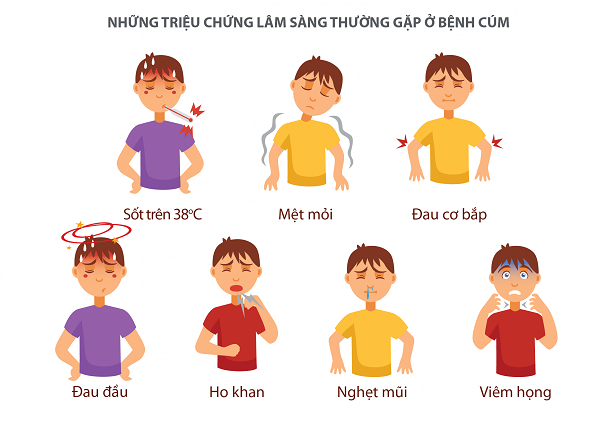 English
EnglishSeasonal flu in children: Symptoms and complications. The role of nutrition in prevention and treatment support
Seasonal flu is a common acute respiratory infection, especially affecting the health of young children. Early recognition of seasonal flu symptoms in children such as high fever, cough, sore throat, fatigue is extremely important for timely intervention, preventing dangerous complications. At the same time, this gives parents important principles to create a nutritional diet to support immune enhancement and increase treatment effectiveness when their children have seasonal flu.

Seasonal flu – a common acute respiratory infection in young children
This article provides scientific and accurate knowledge so you can proactively protect your child’s overall health against the threat of seasonal flu.
1. Seasonal flu and the reasons why children are at high risk
To better understand this threat and why children are particularly susceptible, we need to start with some basic knowledge about the disease.

Seasonal influenza is an acute respiratory infection caused by influenza viruses.
What is seasonal flu?
Seasonal influenza is an acute respiratory infection caused by influenza viruses (Influenza virus types A, B, and sometimes C). The disease spreads easily through the respiratory tract when an infected person coughs, sneezes, or talks, creating droplets containing the virus in the air, or through contact with surfaces contaminated with the virus and then touching the eyes, nose, or mouth[1].
Current situation of seasonal flu
According to the World Health Organization (WHO), there are an estimated 1 billion cases of seasonal influenza worldwide each year, including 3-5 million severe cases and approximately 290,000 to 650,000 influenza-related respiratory deaths[2]. Children under 5 years of age are among the groups with the highest rates of hospitalization and complications.
Why children are at high risk?
There are many factors that make young children more vulnerable to the flu virus:
– Immature immune system: The immune system of young children, especially those under 2 years old, still in the process of development and immature compared to adults. This makes it difficult for children to fight off the flu virus and makes them more susceptible to infection[3].
– Small and narrow respiratory tract: Children’s airways are smaller and more susceptible to blockage and infection when attacked by viruses.
– Highly infectious environments: Children often live in collective environments such as nurseries, schools, and playgrounds, where the flu virus can easily spread from one child to another.
– Difficulty in complying with personal hygiene: Young children do not have the awareness to cover their mouths when coughing/sneezing or wash their hands regularly, increasing the risk of infection.
2. Recognizing seasonal flu symptoms in children: Signs to watch out for
When children show signs of being unwell, early recognition of seasonal flu symptoms is extremely important so that parents can provide proper care and monitor closely. So, what are the signs that your child may have seasonal flu?

Common symptoms of seasonal flu
Common typical symptoms
Parents need to pay attention if your child suddenly shows the following signs[4]:
– Sudden high fever: Usually above 38.5°C, sometimes up to 39-40°C, the child may complain of coldness or shivering.
– Cough: Usually dry, persistent, sometimes lasting even when other symptoms have improved.
– Sore throat: Children may complain of a sore throat, or show signs of loss of appetite or refusal to breastfeed.
– Nasal discharge or congestion: Nasal discharge may initially be clear, then thicken..
– Headache, body aches: Older children may complain of headaches, body aches, especially in the back and legs.
– Tiredness and irritability: This is a very common sign. Children look tired, do not want to play, and cry more than usual.
Symptoms differ in infants and toddlers
Flu symptoms may not be exactly the same in every child:
– Digestive symptoms: Some children may experience vomiting, diarrhea accompanied by respiratory symptoms.
– Atypical symptoms in infants: Infants with flu may not have a high fever, but only have a mild fever accompanied by lethargy, refusal to breastfeed, difficulty breathing or even apnea[5].
– Distinguishing from the common cold: Sometimes parents easily confuse the flu with a cold. The main difference is that seasonal flu often comes on suddenly with a high fever and a very clear feeling of fatigue and body aches. In contrast, a cold usually starts slowly, the main symptoms are a runny nose, stuffy nose, sneezing and a mild or no fever.
3. Dangerous complications of seasonal flu and warning signs that require medical intervention in children
Although most children recover from the flu on their own, parents should never be complacent. Seasonal flu can lead to unwanted complications, especially in young children or children with underlying health conditions. Early recognition of danger signs is key to protecting children.
Complication rate
The US Centers for Disease Control and Prevention (CDC) estimates that tens of thousands of children under the age of 5 are hospitalized each year for flu-related complications[6], ighlighting the potential dangers of the disease in this young age group.
Potential complications of seasonal flu in children: Flu can lead to many other serious health problems:
– Respiratory: Pneumonia due to influenza virus or bacterial superinfection (most common and serious complication), bronchitis, bronchiolitis, exacerbation of existing asthma.

Pneumonia – A Potential Complication of Seasonal Flu
– Ear, nose and throat issues: Acute otitis media (very common in young children), sinusitis.
– Whole body and nervous system: Dehydration (due to high fever, vomiting, diarrhea, poor diet), myositis, myocarditis (heart inflammation), convulsions due to high fever. More serious neurological complications such as encephalitis, meningitis, although rare, can leave serious sequelae[7].
Recognize emergency medical warning signs
Children’s health is always a top priority. Parents should take their children to see a doctor or medical facility immediately if any of the following signs found:
– Rapid breathing, labored breathing, difficulty breathing, chest retraction (skin sinks in between the ribs when breathing).
– Blue skin, lips, or nails.
– Chest pain or tightness.
– Severe muscle pain.
– Signs of dehydration: no urination or wet diaper for 8 hours, dry mouth, crying without tears.
– Convulsion.
– High fever above 40°C or fever that does not respond to antipyretics.
– Lethargic, difficult to wake or unresponsive child.
– Flu symptoms may seem to improve for a short time but then return with a worsening fever and cough.
– The child’s underlying medical condition (such as heart, lung, asthma) worsens.
4. The role of nutrition in preventing and supporting the treatment of seasonal flu in children
In addition to recognizing and treating symptoms, building a solid health foundation for children plays an extremely important part in both preventing and supporting the treatment of seasonal flu. In particular, nutrition is the key.
Nutrition – The foundation for a healthy immune system
Prevention is better than cure, and nutrition is the solid brick that builds a healthy immune system for children. Few people know that up to 70% of the body’s immune “army” is located in the intestines[8]. This means that a healthy digestive system, with a balance of beneficial bacteria, allowing the immune system to work more effectively. A scientific, nutritious diet is the best way to nourish this “army”, support your child better fighting against diseases, including seasonal flu.
Essential nutrients to protect the immune system
To keep your child’s immune “shield” strong, remember to provide enough of the following important nutrients:

Nutrition for children to stay healthy when facing seasonal flu
– Vitamin C: considered a “warrior” that strengthens immune cells, allowing the body to fight viruses more effectively. Parents can find abundant vitamin C in: oranges, tangerines, grapefruit, guava, kiwi, strawberries, papaya, bell peppers, broccoli[9].
– Vitamin D: not only strengthens bones, vitamin D also “coordinates” the activity of the immune system, a lack of vitamin D can make children more susceptible to respiratory infections. The best sources of vitamin D are: fatty fish (salmon, mackerel), egg yolks, mushrooms, and foods fortified with vitamin D such as milk and cereals.
– Zinc: This micronutrient is essential for immune cells to develop and function properly. Zinc deficiency weakens the immune system and makes children more susceptible to illness. Zinc is abundant in: oysters, red meat, chicken, beans, nuts, whole grains.
– Protein: the component that makes up antibodies and immune cells. Providing enough high-quality protein helps the child’s body create enough “weapons” to fight pathogens. Sources of protein include: meat, fish, eggs, milk and dairy products, beans, and peas.
– Iron: important for the proliferation and maturation of immune cells, especially lymphocytes. However, it is important to balance, as excess iron is not good during acute infections. Sources of iron include: red meat, liver, poultry, fish, eggs, dark green leafy vegetables, beans, iron-fortified cereals.
– Probiotics and Prebiotics: Probiotics are considered “warriors” of beneficial bacteria for the intestines, while Prebiotics are the “food” that nourishes these “warriors”. Their combination keeps the intestines healthy, thereby strengthening the immune barrier. Probiotics are found in yogurt, kefir, fermented foods; Prebiotics are found in garlic, onions, bananas, oats, asparagus, whole grains.
– Colostrum: Colostrum is considered the “first immune gift of life”, rich in natural antibodies (IgG), lactoferrin and growth factors. They enables equipment of the baby’s immature immune system with “weapons”, especially effective in preventing respiratory and digestive infections[10].
In the journey of children caring, building a healthy immune system is always the top priority of every parent, especially when facing epidemic seasons such as seasonal flu. However, ensuring that children receive all the necessary nutrients through daily meals is sometimes a challenge, especially for children with poor appetite, poor digestion or high nutritional needs during the development stage. Understanding that, ColosCare 24h was researched and developed by Nutricare and the Nutricare Medical Nutrition Institute – USA (NMNI-USA) as a nutritional solution to support comprehensive and effective enhancement of children’s resistance. The core point that makes the difference of Coloscare 24h is the source of 24h colostrum imported from the US, providing an exceptionally high IgG 1200 antibody content, clinically proven to reduce the rate of respiratory infections and enhance resistance. This abundant amount of antibodies acts as elite “guards”, directly supporting the child’s immature immune system to effectively fight viruses and disease-causing bacteria, especially respiratory and digestive infections. In addition, the product supplements 10 billion Postbiotic probiotics, HMO, and fiber to balance the intestinal microflora – an important foundation for a healthy immune system. The formula is completed with 56 essential nutrients combined with easily absorbed protein, calciu,m and vitamin D3, ensuring a comprehensive nutritional foundation, providing maximum support for the development and immune function of children. ColosCare 24h is a reliable choice for children to strengthen their strong immune “shield”, reduce minor illnesses, so that children can be healthy and confident in exploring the world.
Golden nutritional principles for children with flu
When children are sick, eating becomes a “challenge”. Parents need to be patient and apply the following principles to help children recover quickly:
– Top priority: Rehydration and electrolytes: High fever, rapid breathing, vomiting or diarrhea (if any) can easily cause dehydration in children. Children should be encouraged to drink frequently, in small sips. Prioritize filtered water, properly mixed electrolyte solution (Oresol), milk (breast milk, formula, fresh milk depending on age), diluted fruit juice (no added sugar), broth, and thin soup[11].
– Provide enough energy: Children need energy to fight diseases. Choose soft, easy-to-digest, easy-to-swallow foods such as porridge, soup, pureed foods. Divide into many small meals a day (5-6 meals or more) instead of 3 main meals so that children can absorb easily and do not feel forced to eat.
– Increase foods rich in vitamins and minerals: Add green vegetables and fresh fruits (can be made into smoothies, juices or steamed) to provide vitamins and antioxidants. Dishes prepared in the form of soups and stews are also a good choice as they thin phlegm and provide easily absorbed nutrients.
Conclusion
In short, seasonal flu in children is a noteworthy health issue, with the potential for complications if not recognized and treated properly. Understanding the symptoms, especially the warning signs of danger, is extremely necessary for parents to seek timely medical support. At the same time, scientific nutrition plays an indispensable foundational role, both allowing to strengthen the natural immune system that effectively prevents disease and actively supporting the recovery process, minimizing the impact of the disease when children are unfortunately infected. Investing in nutrition is investing in a strong immune shield, protecting the health and future development of your child.
References
|
